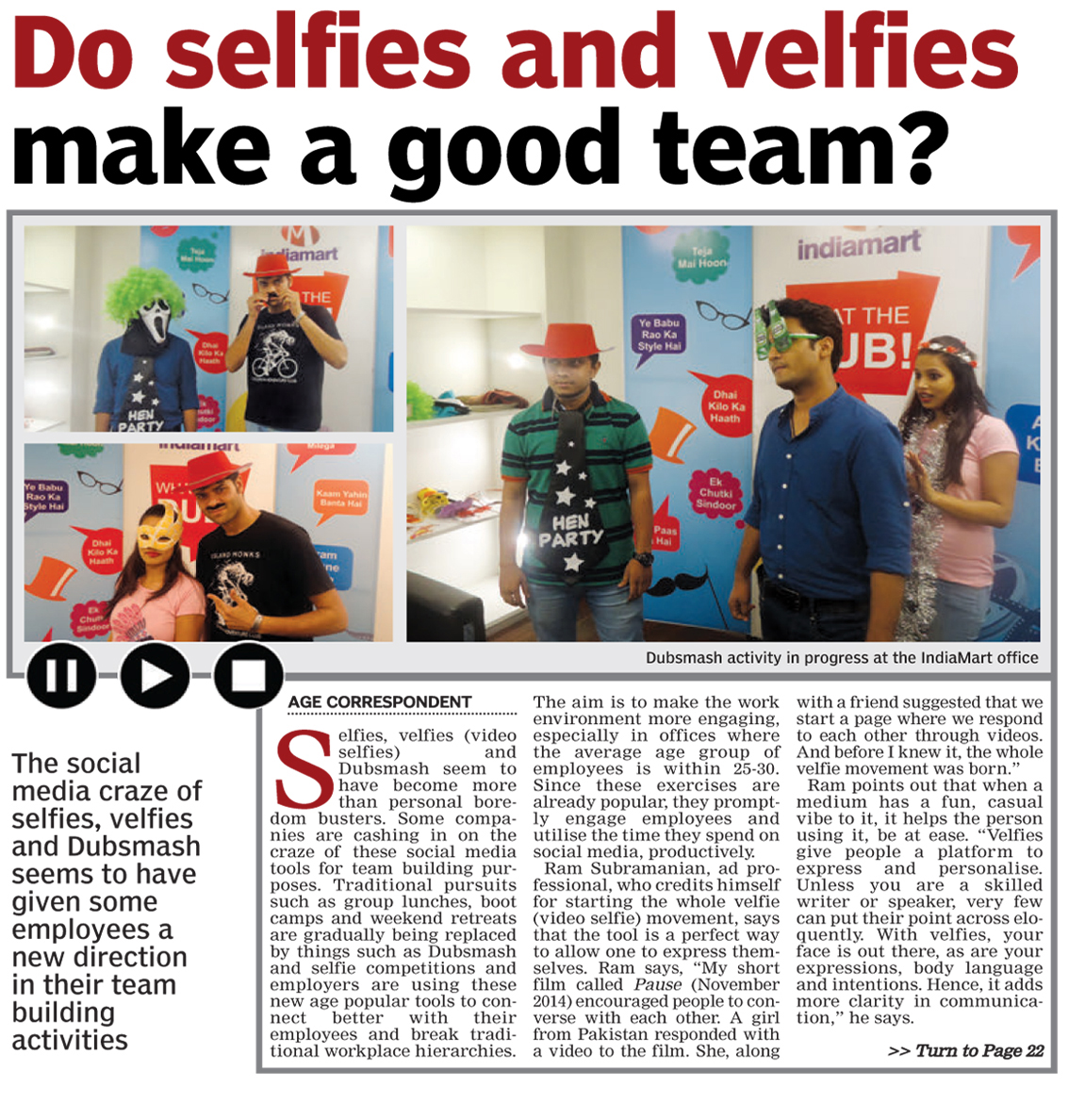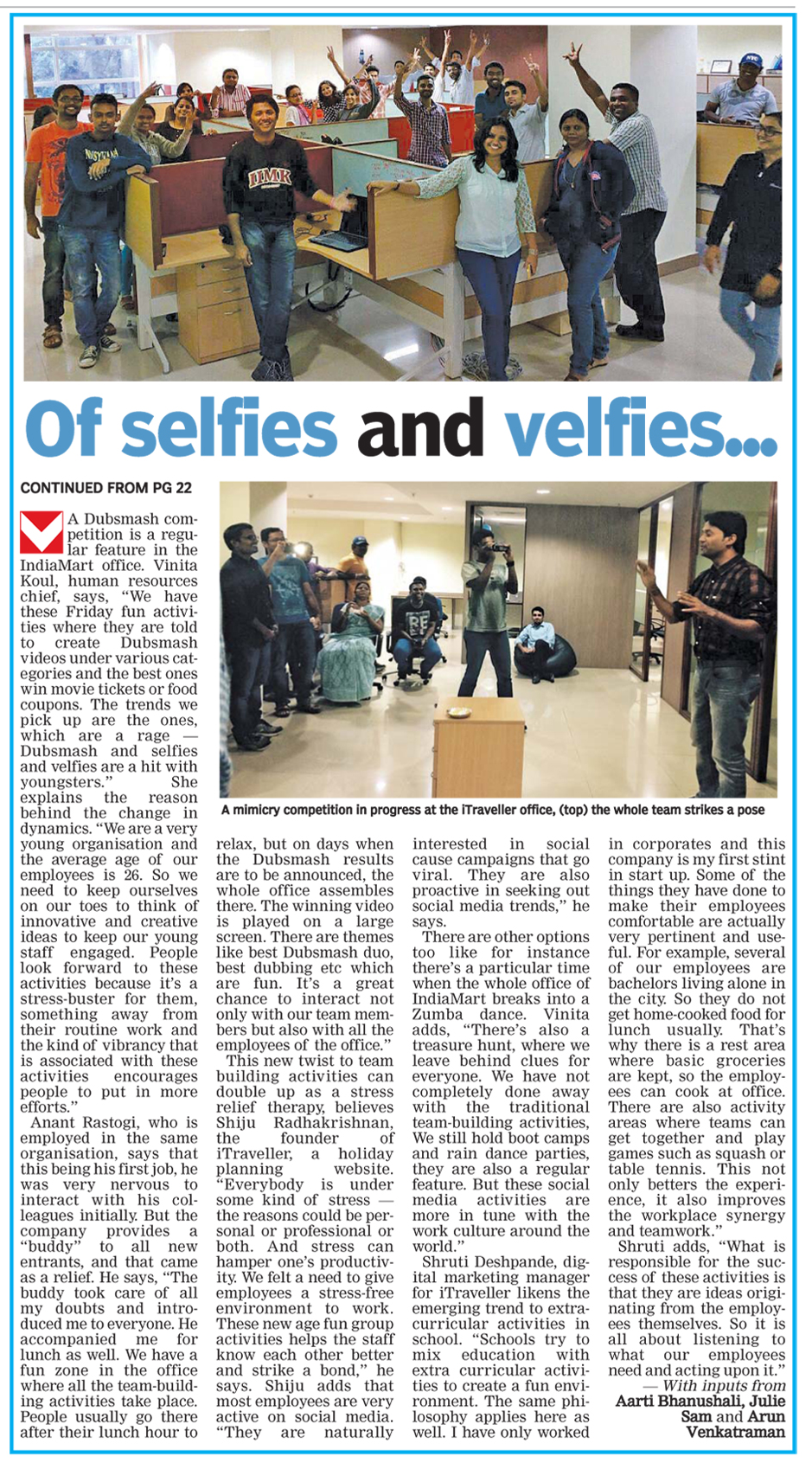The Asian Age
The social media craze of selfies, velfies and Dubsmash seems to have given some employees a new direction in their team building activities Selfies, velfies (video selfies) and Dubsmash seem to have become more than personal boredom busters. Some companies are cashing in on the craze of these social media tools for team building purposes. Traditional pursuits such as group lunches, boot camps and weekend retreats are gradually being replaced by things such as Dubsmash and selfie competitions and employers are using these new age popular tools to connect better with their employees and break traditional workplace hierarchies. The aim is to make the work environment more engaging, especially in offices where the average age group of employees is within 25-30. Since these exercises are already popular, they promptly engage employees and utilise the time they spend on social media, productively.
Ram Subramanian, ad professional, who credits himself for starting the whole velfie (video selfie) movement, says that the tool is a perfect way to allow one to express themselves. Ram says, “My short film called Pause (November 2014) encouraged people to converse with each other. A girl from Pakistan responded with a video to the film. She, along with a friend suggested that we start a page where we respond to each other through videos. And before I knew it, the whole velfie movement was born.”
Ram points out that when a medium has a fun, casual vibe to it, it helps the person using it, be at ease. “Velfies give people a platform to express and personalise. Unless you are a skilled writer or speaker, very few can put their point across eloquently. With velfies, your face is out there, as are your expressions, body language and intentions. Hence, it adds more clarity in communication,” he says.
A Dubsmash competition is a regular feature in the IndiaMart office. Vinita Koul, human resources chief, says, “We have these Friday fun activities where they are told to create Dubsmash videos under various categories and the best ones win movie tickets or food coupons. The trends we pick up are the ones, which are a rage —Dubsmash and selfies and velfies are a hit with youngsters.” She explains the reason behind the change in dynamics. “We are a very young organisation and the average age of our employees is 26. So we need to keep ourselves on our toes to think of innovative and creative ideas to keep our young staff engaged. People look forward to these activities because it’s a stress-buster for them, something away from their routine work and the kind of vibrancy that is associated with these activities encourages people to put in more efforts.”
Anant Rastogi, who is employed in the same organisation, says that this being his first job, he was very nervous to interact with his colleagues initially. But the company provides a “buddy” to all new entrants, and that came as a relief. He says, “The buddy took care of all my doubts and introduced me to everyone. He accompanied me for lunch as well. We have a fun zone in the office where all the team-building activities take place. People usually go there after their lunch hour to relax, but on days when the Dubsmash results are to be announced, the whole office assembles there. The winning video is played on a large screen. There are themes like best Dubsmash duo, best dubbing etc which are fun. It’s a great chance to interact not only with our team members but also with all the employees of the office.”
This new twist to team building activities can double up as a stress relief therapy, believes Shiju Radhakrishnan, the founder of iTraveller, a holiday planning website. “Everybody is under some kind of stress —the reasons could be personal or professional or both. And stress can hamper one’s productivity. We felt a need to give employees a stress-free environment to work. These new age fun group activities helps the staff know each other better and strike a bond,” he says. Shiju adds that most employees are very active on social media. “They are naturally interested in social cause campaigns that go viral. They are also proactive in seeking out social media trends,” he says.
There are other options too like for instance there’s a particular time when the whole office of IndiaMart breaks into a Zumba dance. Vinita adds, “There’s also a treasure hunt, where we leave behind clues for everyone. We have not completely done away with the traditional team-building activities, We still hold boot camps and rain dance parties, they are also a regular feature. But these social media activities are more in tune with the work culture around the world.”
Shruti Deshpande, digital marketing manager for iTraveller likens the emerging trend to extra-curricular activities in school. “Schools try to mix education with extra curricular activities to create a fun environment. The same philosophy applies here as well. I have only worked in corporates and this company is my first stint in start up. Some of the things they have done to make their employees comfortable are actually very pertinent and useful. For example, several of our employees are bachelors living alone in the city. So they do not get home-cooked food for lunch usually. That’s why there is a rest area where basic groceries are kept, so the employees can cook at office. There are also activity areas where teams can get together and play games such as squash or table tennis. This not only betters the experience, it also improves the workplace synergy and teamwork.”
Shruti adds, “What is responsible for the success of these activities is that they are ideas originating from the employees themselves. So it is all about listening to what our employees need and acting upon it.”



